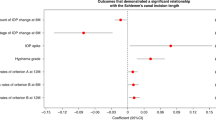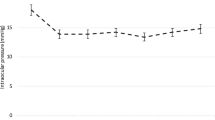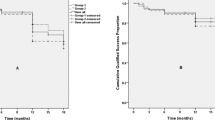Abstract
Objective
To evaluate the safety and efficacy of gonioscopy-assisted transluminal trabeculotomy (GATT) using a marker suture which could be a viable low cost alternative to an illuminated micro catheter, by helping the surgeon identify obstruction to suture passage, and estimate the degree of Schlemm’s canal cannulated.
Subject/Methods
Thirty four eyes with 360° of open angles with uncontrolled IOP despite maximal medical therapy, non-compliant to medical therapy or failed incisional glaucoma surgery underwent GATT. 5-0 or 6-0 Prolene® suture was used to cannulate Schlemm’s canal. An 8-0 Vicryl® suture was tied around the trailing portion of the Prolene® suture and acted as a guide to estimate the length of Schlemm’s canal negotiated. The degree of trabecular shelf seen was noted postoperatively.
Results
Mean baseline IOP was 24.7 ± 8.8 mm Hg (range 13–54 mmHg). Six patients had appositional angle closure and the rest had open angles. Patients were followed up for a period of 45.0 ± 14.6weeks (range 6 weeks-2 years). The mean IOP 6 weeks after surgery was 13 ± 3.3 mm Hg, and at 1 year was 13.5 ± 2.6 mm Hg. Mean degrees of cannulation achieved was 264.5 ± 84.0˚ (90-360˚). The mean number of medications prior to surgery was 2.1 ± 1.0 and at 6 months review was 0.15 ± 0.3. The absolute success was 92.6% 1 year after surgery. Nine patients lost some of their trabecular shelf in the postoperative period, but this did not seem to affect the short term success rate.
Discussion
Suture GATT is a safe and effective procedure to lower IOP even in patients with partial cannulation. Adding a marker suture is a useful adjunct to help identify the length of Schlemm’s canal successfully cannulated and monitor progress of the Prolene® suture.
Similar content being viewed by others
Log in or create a free account to read this content
Gain free access to this article, as well as selected content from this journal and more on nature.com
or
References
Grant WM. Further studies on facility of flow through the trabecular meshwork AMA Arch Ophthalmol. 1958;60:523–33.
Grover DS, Godfrey DG, Smith O, Feuer WJ, Montes de Oca I, Fellman RL. Gonioscopy-assisted transluminal trabeculotomy, Ab interno trabeculotomy technique report and preliminary results. Ophthalmology. 2014;121:855–61.
Grover DS, Godfrey DG, Smith O, et al. Outcomes of gonioscopy-assisted transluminal trabeculotomy (GATT) in eyes with prior incisional glaucoma surgery. J Glaucoma. 2017;26:41–45.
Grover DS, Fellman RL. Gonioscopy-assisted transluminal trabeculotomy (GATT): thermal suture modification with a dye-stained rounded tip. J Glaucoma. 2016;25:501–4.
Grover DS, Smith O, Fellman RL, Godfrey DG, Gupta A, Montes de Oca I, et al. Gonioscopy-assisted transluminal trabeculotomy: an ab interno circumferential trabeculotomy 24 months follow-up. J Glaucoma. 2018;27:393–401.
Hodapp E, Parrish RK II, Anderson DR (eds). Clinical decisions in glaucoma. 1st edition (St. Louis: The CV Mosby Co. 1993) 52–61.
Rahmatnejad K, Pruzan NL, Amanullah S, Shaukat BA, Resende AF, Waisbourd M, et al. Surgical outcomes of gonioscopy-assisted transluminal trabeculotomy in patients with open angle glaucoma. J Glaucoma. 2017;26:1137–1143.
Baykara M, Poroy C, Erseven C. Surgical outcomes of combined gonioscopy ‑ assisted transluminal trabeculotomy and cataract surgery. Indian J Ophthalmol. 2019;67:505–8.
Hirabayashi LeeD, King JT, Thomsen S, An JA. Comparison of surgical outcomes of 360 ° circumferential trabeculotomy versus sectoral excisional goniotomy with the kahook dual blade at 6 months. clinical. Ophthalmology. 2019;13:2017–24.
Rosenquist R, Epstein D, Melamed S, Johnson M. Outflow resistance of enucleated human eyes at two different perfusion pressures and different extents of trabeculotomy. Curr Eye Res. 1989;8:1233–40.
Bao W, Kawase K, Huang H, Sawada A, Yamamoto T. The long-term outcome of trabeculotomy: comparison with filtering surgery in Japan. BMC Ophthalmol. 2019;19:1–8.
Guo CY, Qi XH, Qi JM. Systematic review and Meta-analysis of treating open angle glaucoma with gonioscopy-assisted transluminal trabeculotomy. Int J Ophthalmol. 2020;13:317–24.
Grover DS, Smith O, Fellman RL, Godfrey DG, Butler MR, Montes de Oca I, et al. Gonioscopy assisted transluminal trabeculotomy: an ab interno circumferential trabeculotomy for the treatment of primary congenital glaucoma and juvenile open angle glaucoma. Br J Ophthalmol. 2015;99:1092–1096.
Sato T, Hirata A, Mizoguchi T. Prospective, noncomparative, nonrandomized case study of short-term outcomes of 360° suture trabeculotomy ab interno in patients with open-angle glaucoma. Clin Ophthalmol. 2015;9:63–68.
Smith BL, Ellyson AC, Kim WI Trabectome-initiated gonioscopy-assisted transluminal trabeculotomy. Mil Med. 2018;183 (Suppl 1), 146–9.
Yalinbas Duygu, Aktas Zeynep, Hepsen Ibrahim, An NilayDilekmen. unusual complication of combined gonioscopy-assisted transluminal trabeculotomy and phacoemulsification: vision loss due to intracapsular hematoma. Int Ophthalmol. 2018;38:2223–6.
Pandav SS, Seth NG, Arora A, Thattaruthody F, Jurangal A, Kaushik S, et al. Intraocular pressure reduction in a spectrum of angle closure disease following cataract extraction. Indian J Ophthalmol. 2019;67:1433–8.
Acknowledgements
We thank statisticians from beyond p value for the statistical analysis. Dr. Craig J Chaya supported in part by an Unrestricted Grant from Research to Prevent Blindness, Inc., New York, NY, to the Department of Ophthalmology & Visual Sciences, University of Utah. This study has not been funded by anyone.
Author information
Authors and Affiliations
Contributions
FA was responsible extracting and analysing data, interpreting results, updating reference lists and creating “Summary of findings” tables. MR contributed to interpreting results, designing the review protocol, screening potentially eligible studies, extracting and analysing data, interpreting results and writing the report. CR was responsible for data extraction, designing the review protocol and providing feedback on the report. CJC helped interpret the results, design the study protocol and provided feedback on the report. VM contributed to extracting and analysing data and interpreting results.
Corresponding author
Ethics declarations
Competing interests
The authors declare no competing interests.
Additional information
Publisher’s note Springer Nature remains neutral with regard to jurisdictional claims in published maps and institutional affiliations.
Rights and permissions
About this article
Cite this article
Asafali, F., Rajamani, M., Ramamurthy, C. et al. Relationship of degrees of gonioscopy assisted transluminal trabeculotomy and trabecular shelf to success using a marker suture technique. Eye 37, 132–138 (2023). https://doi.org/10.1038/s41433-021-01838-x
Received:
Revised:
Accepted:
Published:
Issue date:
DOI: https://doi.org/10.1038/s41433-021-01838-x
This article is cited by
-
Influence of suture thickness on clinical outcomes in gonioscopy-assisted transluminal trabeculotomy: a comparative analysis of 5–0 and 6–0 polypropylene sutures
International Ophthalmology (2025)
-
Evaluation of peripheral anterior synechia formation following gonioscopy-assisted transluminal trabeculotomy surgery
International Ophthalmology (2023)



